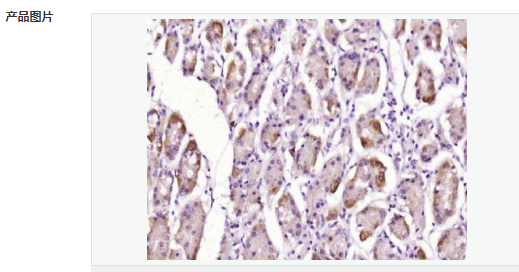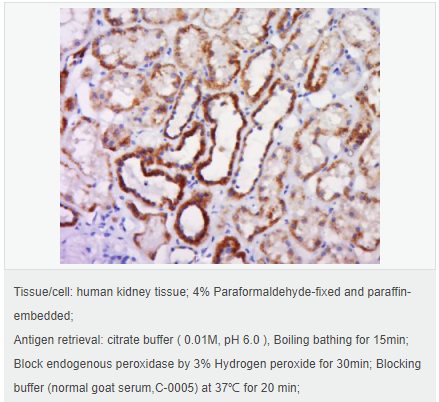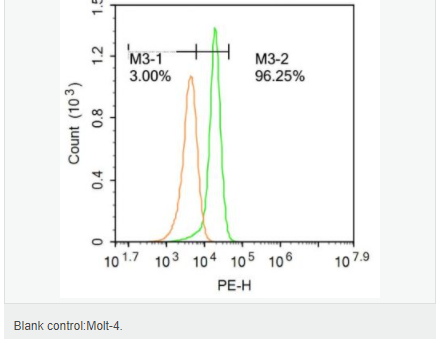
货号
产品规格
售价
备注
BN41485R-50ul
50ul
¥1486.00
交叉反应:Human 推荐应用:IHC-P,IHC-F,IF,Flow-Cyt,ELISA
BN41485R-100ul
100ul
¥2360.00
交叉反应:Human 推荐应用:IHC-P,IHC-F,IF,Flow-Cyt,ELISA
BN41485R-200ul
200ul
¥3490.00
交叉反应:Human 推荐应用:IHC-P,IHC-F,IF,Flow-Cyt,ELISA
| 英文名称 | Caspase-10 |
| 中文名称 | 半胱胺酸蛋白酶-10抗体 |
| 别 名 | ALPS 2; ALPS2; Apoptosis related cysteine peptidase; Apoptotic protease Mch 4; CASP 10; CASP10; CASP10 protein; Caspase 10 apoptosis related cysteine peptidase; Caspase 10 apoptosis related cysteine protease; Caspase10; FADD Like Ice 2; Fas Associated Death Domain Protein; FAS associated death domain protein interleukin 1B converting enzyme 2; FLICE 2; FLICE2; ICE Like Apoptotic Protease 4; Interleukin 1B Converting Enzyme 2; MCH 4; MCH4. |
| 研究领域 | 细胞生物 免疫学 细胞凋亡 |
| 抗体来源 | Rabbit |
| 克隆类型 | Polyclonal |
| 交叉反应 | Human, |
| 产品应用 | ELISA=1:5000-10000 IHC-P=1:100-500 IHC-F=1:100-500 Flow-Cyt=0.2ug/test IF=1:100-500 (石蜡切片需做抗原修复) not yet tested in other applications. optimal dilutions/concentrations should be determined by the end user. |
| 分 子 量 | 59kDa |
| 细胞定位 | 细胞浆 |
| 性 状 | Liquid |
| 浓 度 | 1mg/ml |
| 免 疫 原 | KLH conjugated synthetic peptide derived from human Caspase-10 subunit p12:431-521/521 |
| 亚 型 | IgG |
| 纯化方法 | affinity purified by Protein A |
| 储 存 液 | 0.01M TBS(pH7.4) with 1% BSA, 0.03% Proclin300 and 50% Glycerol. |
| 保存条件 | Shipped at 4℃. Store at -20 °C for one year. Avoid repeated freeze/thaw cycles. |
| PubMed | PubMed |
| 产品介绍 | Caspases are a family of intracellular proteases that mediate cell death and are the principal effectors of apoptosis. Caspase 10 (Mch4, ICE-LAP4, FLICE2) plays an important role in apoptosis induced by a variety of inducers such as TNF alpha and Anti-Fas antibody. It is a large prodomain caspase classified together with caspases 2, 8, and 9 as a signaling caspase. Four isoforms of caspase 10 (caspase 10a, 10b, 10c, and 10d) having the same prodomain but different mature large and small subdomain, have been described. Caspase 10 contains two death domains (DED) involved in linking to the death effector domain of the adapter protein FADD and recruiting the complex to TNFR1 and Fas. The inactive procaspase 10 is variably expressed in many tissues and cell lines as a cytosolic protein. The mature form of caspase 10 comprises two subunits, p23/p17 (splice isoforms) and p12. Interestingly, a caspase 9- dependent processing of caspase 10 by caspase 6 in cell-free extracts has recently been suggested. Caspase 10 can cleave and activate caspases 3, 4, 6, 7, 8, and 9. This is followed by cleavage of numerous key proteins, including the nuclear protein PARP. Function: Involved in the activation cascade of caspases responsible for apoptosis execution. Recruited to both Fas- and TNFR-1 receptors in a FADD dependent manner. May participate in the granzyme B apoptotic pathways. Cleaves and activates caspase-3, -4, -6, -7, -8, and -9. Hydrolyzes the small- molecule substrates, Tyr-Val-Ala-Asp-|-AMC and Asp-Glu-Val-Asp-|-AMC. Subunit: Heterotetramer that consists of two anti-parallel arranged heterodimers, each one formed by a 23/17 kDa (p23/17) (depending on the splicing events) and a 12 kDa (p12) subunit (By similarity). Self-associates. Interacts with FADD and CASP8. Found in a Fas signaling complex consisting of FAS, FADD, CASP8 and CASP10. Tissue Specificity: Detectable in most tissues. Lowest expression is seen in brain, kidney, prostate, testis and colon. Post-translational modifications: Cleavage by granzyme B and autocatalytic activity generate the two active subunits. Phosphorylated upon DNA damage, probably by ATM or ATR. DISEASE: Defects in CASP10 are the cause of autoimmune lymphoproliferative syndrome type 2A (ALPS2A) [MIM:603909]. ALPS2 is characterized by abnormal lymphocyte and dendritic cell homeostasis and immune regulatory defects. Defects in CASP10 are a cause of familial non-Hodgkin lymphoma (NHL) [MIM:605027]. NHL is a cancer that starts in cells of the lymph system, which is part of the body's immune system. NHLs can occur at any age and are often marked by enlarged lymph nodes, fever and weight loss. Similarity: Belongs to the peptidase C14A family. Contains 2 DED (death effector) domains. SWISS: Q92851 Gene ID: 843 Database links: Entrez Gene: 843 Human Omim: 601762 Human SwissProt: Q92851 Human Unigene: 5353 Human Important Note: This product as supplied is intended for research use only, not for use in human, therapeutic or diagnostic applications. |


